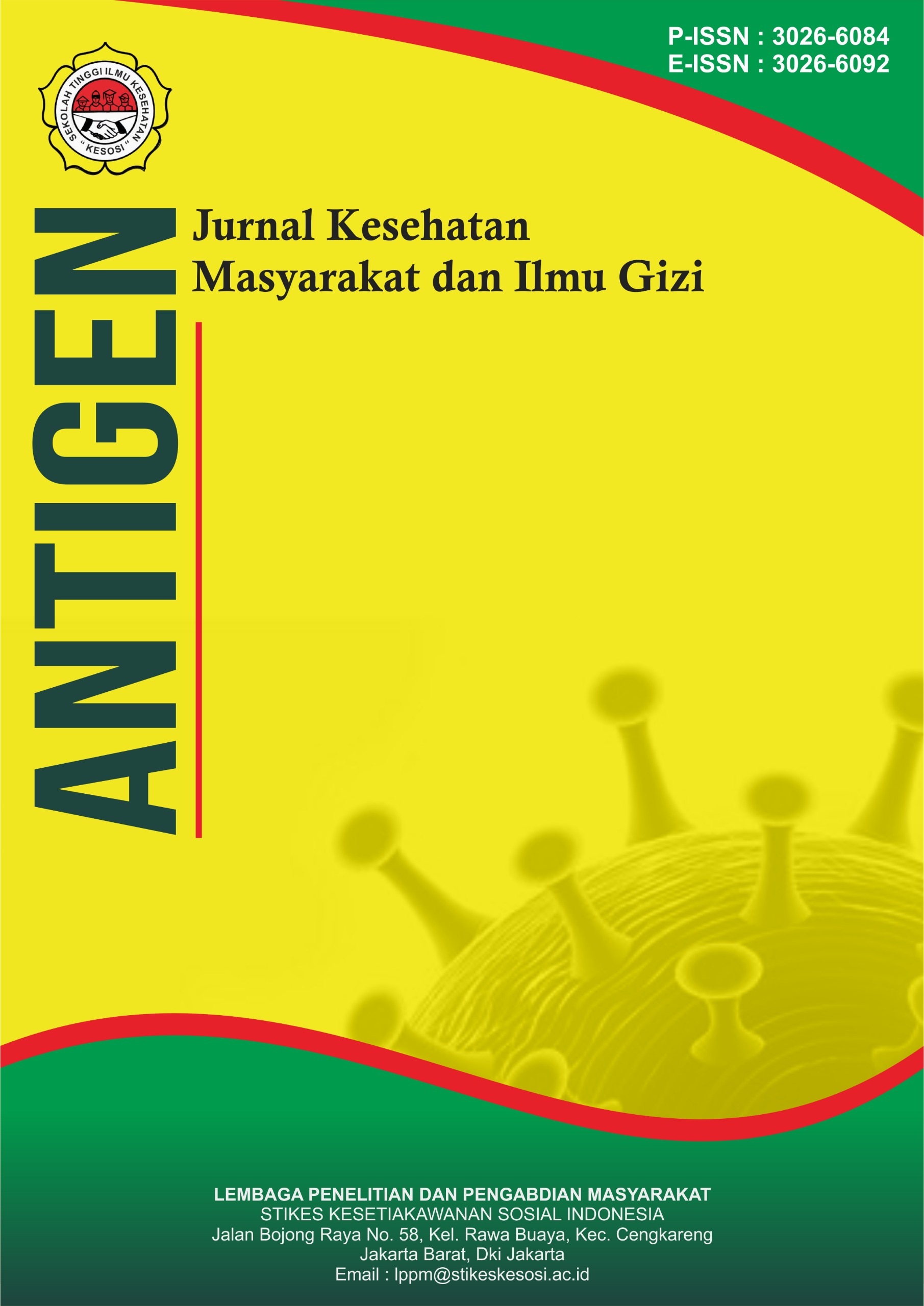Pengaruh Pelatihan Terhadap Pengetahuan Tentang Gizi Buruk dan Inter-Professional Collaboration Petugas Puskesmas
DOI:
https://doi.org/10.57213/antigen.v2i4.451Keywords:
Training, Poor Nutrition, Inter-professional CollaborationAbstract
Very complex health problems require treatment involving all health professionals. The nutritional status of children is one of the important things to prepare a quality generation. Health education in the form of training is expected to change the competence of collaboration across healthcare professionals. The aim of the study was to determine the effect of training on health workers on knowledge about malnutrition and collaboration across professions. This study uses a Mix-Method approach with triangulation techniques using a questionnaire for qualitative stages by conducting a content analysis and on a quantitative stage using the research design method "Pre Experiment" with a research design using "one group pre and post-test design". Test for normality using Shapiro -Wilk. Statistical analysis using the Wilcoxon test and paired T-test. The Results showing are analysis content informs that the training has been going well and is able to increase participants' knowledge. Statistical test results show that nutrition knowledge before training has a mean of 4.50 and after training has a mean of 4,467. This does not show an increase in average. The results of the statistical test, namely the test T-test showed p- value = 0.586 (p> 0.05) which means that there is no difference in mean knowledge about nutrition before and after treatment. As for knowledge about collaboration before training has a mean of 8.75 and after training has a mean of 10.67. This shows an increase in average. Statistical test results show p-value = 0.008 (p <0.05) which shows that there is a difference in mean knowledge about collaboration before the treatment in the module testing group. So, Cross-professional collaboration training in handling malnutrition affects changes in health worker knowledge. There are differences in changes in knowledge of malnutrition and collaboration across professions before and after training.
References
Alfridsyah A., Ichsan I., dan Miko A. (2013). Perbedaan Penggunaan Standar Baru Antropometri WHO-2006 terhadap Peningkatan Pengetahuan dan Penilaian Status Gizi pada Tenaga Gizi Pelaksana di Kota Banda Aceh Tahun 2009. Buletin Penelitian Sistem Kesehatan. 16 (2 Apr).
Amiruddin R. (2007). Anemia Defisiensi Zat Besi pada Ibu Hamil di Indonesia. Jurnal Medika Unhas.
Black et al. (2013). Maternal and Child Undernutrition and Overweight in Low-Income and Middle-Income Countries. The lancet. 382 (9890); 427-451.
Borst J. Inter-professional Collaboration: An Introduction. Tartalom/Table of contents. 2011:32.
Dasar RK. RISKESDAS. (2013). Badan Penelitian dan Pengembangan Badan Kesehatan Kementerian Republik Indonesia.
Departemen Kesehatan Jeneponto. (2015). Laporan Pelaksanaan Surveilans Gizi tingkat Kabupaten Jeneponto.
Departemen Kesehatan Republik Indonesia. (2001). Modul Pelatihan Metode dan Teknologi Diklat (METEK). Pusat Pendidikan dan Latihan Pegawai Depkes RI, Jakarta. 9-11.
Ellis et.al. (2007). Effect of Pharmacy Practice Residency Training on Residents' Knowledge of and Interest in Clinical Research. American Journal of Health-System Pharmacy. 64(19).
Febria C., Masrul M dan Chundrayetti E. (2018). Hubungan Kadar Kalsium Dalam ASI, PASI Dan MPASI dari Asupan Bayi dengan Panjang Badan Bayi Usia 6-12 Bulan di Wilayah Kerja Puskesmas Lubuk Buaya Padang 2017. Jurnal Kesehatan Andalas. 6(3): 662-667.
Green BN and Johnson CD. (2015). Inter-Professional Collaboration in Research, Education, And Clinical Practice: Working Together for a Better Future. Journal of Chiropractic Education. 29(1): 1-10.
Indonesia KKR. (2015) Rencana Strategis Kementerian Kesehatan tahun 2015-2019. Bainbridge et. al. (2010). Competencies for Inter-Professional Collaboration. Journal of Physical Therapy Education. 24(1); 6.
Notoatmodjo S. (2007). Kesehatan Masyarakat. Ilmu dan Seni. Rineka Cipta. Jakarta. Notoatmodjo S. (2007). Pendidikan dan Prilaku Kesehatan. Jakarta: Rineka Cipta.
Palutturi S. (2007). Determinan Kinerja Bidan di Puskesmas Tahun 2006. Jurnal Manajemen Pelayanan Kesehatan. 10(04).
Paridah C, A dan Thaha, R. (2014). The Role of the Center for Prenatal and Postnatal Health Care and Information Cadres in Integrated Care for Preconception Womenin the Pattingalloang Community Health Center Area. JURNAL MKMI, 102- 109.
Posthumus et al. (2013). Bridging between Professionals in Perinatal Care : towards Shared Care in the Netherlands. Maternal and Child Health Journal. 17(10); 1981-1989.
Purwanto MN. (1990). Psikologi pendidikan. Remaja Rosdakarya.
Renyoet BS., Hadju V dan Rochimiwati S. (2012). Hubungan Pola Asuh Dengan Kejadian Stunting Anak Usia 6—23 Bulan di Wilayah Pesisir Kecamatan Tallo Kota Makassar. Jurnal Nutrient Science (PA-NSC), 1-13.
Rodriguez et. al. (2008). Outcomes of Inter-professional Collaboration for Hospitalized Cancer Patients. Cancer nursing. 31(2); 18-27.
Sakti RE., Hadju V dan Rochimiwati SN. (2013). Hubungan Pola Pemberian MP-ASI dengan Status Gizi Anak Usia 6-23 Bulan di Wilayah Pesisir Kecamatan Tallo Kota Makassar Tahun 2013. Jurnal MKMI K.
Saleh PA., Amir MY dan Palutturi S. (2012). Hubungan Faktor Sosial dan Psikologis Dengan Pemanfaatan Pelayanan Kesehatan di RS Bhayangkara Makassar. Jurnal Penelitian Administrasi dan Kebijakan Kesehatan FKM Universitas Hasanuddin.
Seif NY and Aziz MA. (2000) Effect of Breast Self-Examination Training Program on Knowledge, Attitude and Practice of a Group of Working Women. J Egypt Natl Canc Inst. 12(2); 105-115.
Sujianto U .(2014). Kepatuhan Perawat dalam penerapan kewaspadaan universal di Rumah sakit dokter Kariadi Semarang Tahun 2013. Paper presented at: Prosising seminar nasional & Internasional .
Suliha U. (2002). Pendidikan Kesehatan dalam Keperawatan. Jakarta: Penerbit Buku Kedokteran EGC.
Sul-Sel DKp. (2015). Profil kesehatan Sulawesi Selatan.
Sumarni S. (2015) Peran Sarjana Kesehatan Masyarakat dalam Gerakan Penyelamatan 1000 HPK untuk Menurunkan Stunting dan Angka Kematian Ibu. Seminar & Saresehan Nasional Kesehatan Masyarakat. pp.20-30.
Susanty dkk. (2012). Hubungan pola pemberian ASI dan MP-ASI dengan gizi buruk pada anak 6-24 bulan di Kelurahan Pannampu Makassar. Media Gizi Masyarakat Indonesia. 1(2); 97-103.
Syam dkk. (2016). Micronutrients and growth of children; a literature review.International Journal of Medical Science and Public Health. 5(10): 1981-1987.
Unicef. (2012). Ringkasan kajian kesehatan ibu dan anak.
World Health Organization. (2010). Framework for Action on Inter-professional Education & Collaborative Practice. 64.
Downloads
Published
Issue
Section
License
Copyright (c) 2024 Antigen : Jurnal Kesehatan Masyarakat dan Ilmu Gizi

This work is licensed under a Creative Commons Attribution-ShareAlike 4.0 International License.






